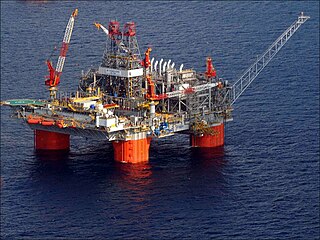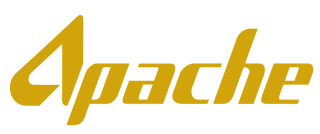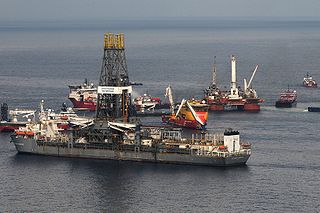| Mad Dog Oil Field | |
|---|---|
The Mad Dog spar platform | |
Location of Mad Dog Oil Field | |
| Country | United States |
| Region | Gulf of Mexico |
| Location | Green Canyon |
| Block | 825, 826 and 782 |
| Offshore/onshore | Offshore |
| Coordinates | 27°11′18″N91°5′12″W / 27.18833°N 91.08667°W Coordinates: 27°11′18″N91°5′12″W / 27.18833°N 91.08667°W |
| Operator | BP |
| Partners | BP BHP Billiton Chevron Corporation |
| Field history | |
| Discovery | May 1998 |
| Start of production | 2005 |
| Production | |
| Estimated oil in place | 450 million barrels (~6.1×107 t) |
Mad Dog Oil Field is an offshore oil field located along the Sigsbee Escarpment at Green Canyon blocks 825, 826 and 782, Western Atwater Foldbelt, Gulf of Mexico. The field is located about 190 miles (310 km) south of New Orleans and 150 miles (240 km) southwest of Venice, Louisiana, United States. It is in the depth of 5,000 to 7,000 feet (1,500 to 2,100 m) of water. [1]
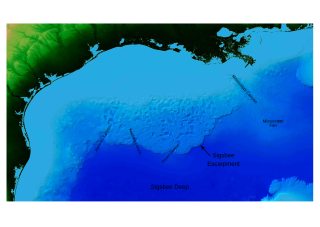
The Sigsbee Escarpment is a major bathymetric feature of the Gulf of Mexico, extending for about 560 kilometres. It separates the lower continental slope of the northern gulf from the abyssal plain of the Sigsbee Deep and has up to 900 m (3,000 ft) of relief across it. It has formed as a result of salt tectonics, due to the effects of loading of a thick layer of Jurassic halite by Upper Jurassic to Cenozoic sedimentary rocks.
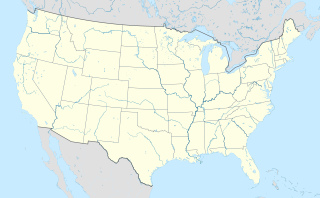
Green Canyon is an area in the Gulf of Mexico that is rich in oil fields and under the control of the Bureau of Ocean Energy Management. Among other oil fields Green Canyon consist of Atlantis operated by BP, Marco Polo and K2 operated by Anadarko Petroleum, Manatee operated by Shell, Shenzi operated by BHP Billiton, Droshky operated by Marathon Oil, Tahiti operated by Chevron Corporation.

The Gulf of Mexico is an ocean basin and a marginal sea of the Atlantic Ocean, largely surrounded by the North American continent. It is bounded on the northeast, north and northwest by the Gulf Coast of the United States, on the southwest and south by Mexico, and on the southeast by Cuba. The U.S. states of Texas, Louisiana, Mississippi, Alabama, and Florida border the Gulf on the north, which are often referred to as the "Third Coast", in comparison with the U.S. Atlantic and Pacific coasts.
Contents
The field was discovered in May 1998 and it became operational in 2005. It is owned by BP (60.5%), BHP Billiton (23.9%), and Chevron Corporation (15.6%). The operator is BP. [1]

BP plc is a British multinational oil and gas company headquartered in London, United Kingdom. It is one of the world's seven oil and gas "supermajors", whose performance in 2012 made it the world's sixth-largest oil and gas company, the sixth-largest energy company by market capitalization and the company with the world's 12th-largest revenue (turnover). It is a vertically integrated company operating in all areas of the oil and gas industry, including exploration and production, refining, distribution and marketing, petrochemicals, power generation and trading. It also has renewable energy interests in biofuels and wind power.

Chevron Corporation is an American multinational energy corporation. One of the successor companies of Standard Oil, it is headquartered in San Ramon, California, and active in more than 180 countries. Chevron is engaged in every aspect of the oil, natural gas, and geothermal energy industries, including hydrocarbon exploration and production; refining, marketing and transport; chemicals manufacturing and sales; and power generation. Chevron is one of the world's largest oil companies; as of 2017, it ranked nineteenth in the Fortune 500 list of the top US closely held and public corporations and sixteenth on the Fortune Global 500 list of the top 500 corporations worldwide. It was also one of the Seven Sisters that dominated the global petroleum industry from the mid-1940s to the 1970s.
The gross estimated reserves are ranged from 200 to 450 million barrels (32×106 to 72×106 m3) of oil equivalent. The field has production capacity around 100,000 barrels per day (16,000 m3/d) of oil and 60 million cubic feet per day (1.7×106 m3/d) of natural gas. Oil is transported to Ship Shoal 332B via the Caesar pipeline, while natural gas is transported via the Cleopatra pipeline. [1]

Natural gas, also called "Fossil Gas" is a naturally occurring hydrocarbon gas mixture consisting primarily of methane, but commonly including varying amounts of other higher alkanes, and sometimes a small percentage of carbon dioxide, nitrogen, hydrogen sulfide, or helium. It is formed when layers of decomposing plant and animal matter are exposed to intense heat and pressure under the surface of the Earth over millions of years. The energy that the plants originally obtained from the sun is stored in the form of chemical bonds in the gas.
The field is operated by using a spar oil platform manufactured in Finland. The hull measures are 128 feet (39 m) in diameter and 555 feet (169 m) in length. Its weight is 20,800 tonnes. The deck measures are 220 by 163 feet (67 by 50 m). It includes production facilities with 13 production slots, a drilling riser slot and two service slots, and quarters for 126 personnel. [1] The front-end engineering design of the second spar will be done by Technip. [2]

A spar is a type of floating oil platform typically used in very deep waters, and is named for logs used as buoys in shipping that are moored in place vertically. Spar production platforms have been developed as an alternative to conventional platforms. The deep draft design of spars makes them less affected by wind, wave and currents and allows for both dry tree and subsea production. Spars are most prevalent in the US Gulf of Mexico; however, there are also spars located offshore Malaysia and Norway.
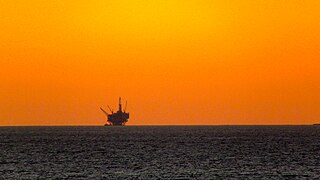
An oil platform, offshore platform, or offshore drilling rig is a large structure with facilities for well drilling to explore, extract, store, and process petroleum and natural gas which lies in rock formations beneath the seabed. In many cases, the platform contains facilities to house the workforce as well.

Technip S.A. was a company that carried out project management, engineering and construction for the energy industry; in 2017 it completed a merger with FMC Technologies to form TechnipFMC. Its headquarters were in the 16th arrondissement of Paris. It has about 38,000 employees and operates in 48 countries.
It was reported on September 16, 2008 that Mad Dog was damaged due to Hurricane Ike. The drilling derrick was toppled over and was on the sea bed. A new drilling package was built and replaced the damaged one on the spar in early 2012.

Hurricane Ike was a powerful tropical cyclone that swept through portions of the Greater Antilles and Northern America in September 2008, wreaking havoc on infrastructure and agriculture, particularly in Cuba and Texas. The ninth tropical storm, fifth hurricane, and third major hurricane of the 2008 Atlantic hurricane season, Ike developed from a tropical wave west of Cape Verde on September 1 and strengthened to a peak intensity as a Category 4 hurricane over the open waters of the central Atlantic on September 4 as it tracked westward. Several fluctuations in strength occurred before Ike made landfall on eastern Cuba on September 8. The hurricane weakened prior to continuing into the Gulf of Mexico, but increased its intensity by the time of its final landfall on Galveston, Texas on September 13. The remnants of Ike continued to track across the United States and into Canada, causing considerable damage inland, before dissipating two days later.




